Camino de Santiago | Phase 1 – September 2006 | Santo Domingo de la Calzada – Viloria de Rioja – Castrojeriz
When we reached Santo Domingo de la Calzada, we were surprised that the church was still open at eight o’clock in the evening. When we entered, a missionary who had lived in Africa was delivering a beautiful sermon in which he reminded the congregation that the mission of the Church was always missionary, in other words, always going towards the other, always building bridges between cultures. This gave me great inspiration because I saw correspondences with my own work: a pilgrim work that leaves the four walls of the studio to meet Nature, a work that goes towards the unknown and is never the same.
Acácio, Orietta and I explained to Paula, who was visiting Santo Domingo de La Calzada for the first time, why there was a hen and a white cockerel inside the hen-house in the church. I wrote down this story and the next day put it up on the board by the bridge built by Saint Dominic: Legend has it that a couple of German pilgrims accompanied by their son stopped at a house in Santo Domingo to rest. The owners of the house had a daughter who fell in love with the boy. On seeing that her love was not answered, she decided to take vengeance. She hid a silver piece inside his bags. When the boy was discovered, he was arrested, taken to court and condemned to death by hanging. The desperate parents then noticed that although the young man had been hanged, he was still alive, and went to report this to the town mayor. The mayor was having his lunch – roast chicken and cock – and said that the boy was as alive as the cock and chicken on his plate – at that moment the cock began to crow and the chicken flew out of the room. They ran to rejoin their son, still alive because Saint Dominic and the Virgin Mary were holding him by the legs.
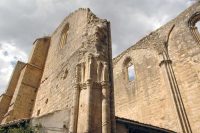
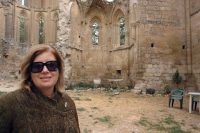
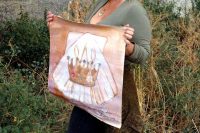
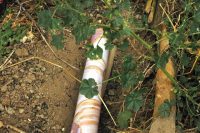
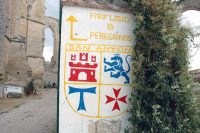
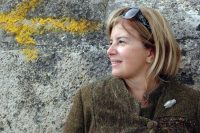
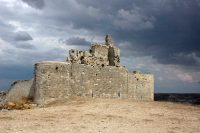
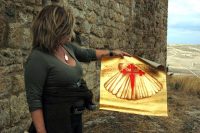
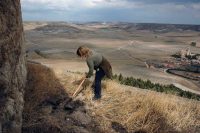
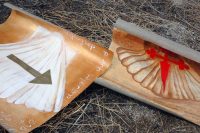
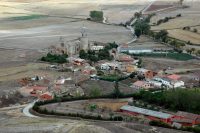
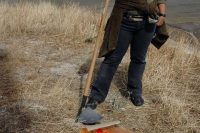
On the following day we went to Viloria de Rioja, the town where Saint Dominic was born, to visit Orietta and Acácio’s hostel. I was very moved when we reached the hostel. One feels immediately that these hosts really treat their guests with love. Upon entering, I saw Paulo’s photo (he is the benefactor of the hostel) and one of my works with the image of the Santiago gateway where the pilgrims lay their hand. I left five paintings in Viloria de Rioja. In Gave de Pau I had left the blue painting of the kimono with golden arrows and two mouths with shells. At night we returned for supper, a meal that Orietta and Acácio always offer the pilgrims. The pilgrims thus have an opportunity to share their experiences and mutually enrich their lives. This contact is necessary because the people are in a very strong spiritual state, capable of perceiving things that they never even imagined. The richness revealed in the simplest things – like having a bed to sleep in, a roof to shelter from the rain, a plate of warm food, a friendly word – becomes essential during the journey. In my work I relive this religious and magical experience, because Nature often presents me with new mysteries. My paintings and the experience that they provide alter my perception of the world, just like walking opens the pilgrim’s eyes to the essence of the journey.
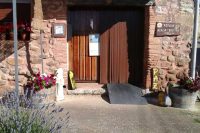
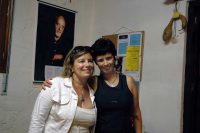
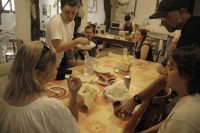
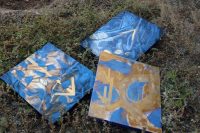
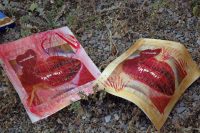
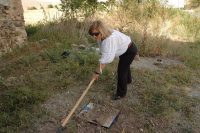
There we were, seventeen people sitting down to dinner in the living room of the hostel, all relishing the privilege of being together after a lonely day’s walking. Acácio and Orietta said a short prayer to thank pilgrims past and present. Paulo’s presence was palpable, for several pilgrims asked to have their picture taken beside his photograph. At that moment I thought of how many pilgrims passed by here guided by his story and his experience… myself among them. I went back to the hotel with my niece and we dreamed: mine were about landslides (for some days I had been dreaming about houses and bridges collapsing); Paula’s were about her angel, for the first time.
I had to spend all of the next day working to finish a painting to deposit in the bed of the river that flows through Santo Domingo. In a large area of the canvas I painted seven panels telling the story of the saint and including shells. In the late afternoon we went down to the bank of the river to plant the painting. The river was completely dry, so I felt it would be ideal to plant my painting on the bed of rocks. The dry leaves on the ground, bathed by the setting sun, gave me the impression that we were already in autumn. It was a very magical moment, and I let my mind become empty while I lay the rocks. When we finished, the hosts went back to their hostel and we decided to walk a little on the rocks. At night Paula and I went to a restaurant where we witnessed a very sinister scene: the roof of a house had collapsed and policemen with torches were looking for someone beneath the debris. I began to pray because I had been dreaming about this for several days, and now was seeing the nightmare materializing before my very eyes. The biggest enigma is that since then I have not dreamed any more about it, as if reality had decided to scare off the dream.
As we had another day in this stage of the journey, I decided to go to Castrojeriz, where there are ruins of a fort.
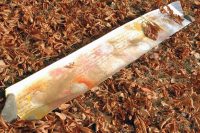
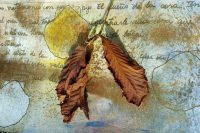
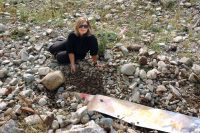
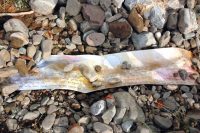
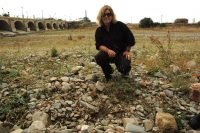
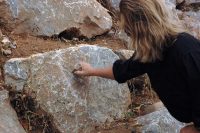
For this stage I worked on four paintings with the signs of the Way: the shell with the cross of Saint James, the shell with the crown of the Virgin, the shell with the arrow, and the shell with the heart of Mary. First we stopped at San Juan de Ortega, after coming across a shepherd and his numerous sheep. We passed by field and after field of sunflowers unpicked and burnt by the scorching sun of Spain. This sight always gives me a feeling of desolation because these flowers that offer us so much are left abandoned. I see in them a sign that everything that is planted must one day be gathered. May time be our ally when we decide to work with it and experience it, but not to abandon it. I do not want my paintings, planted with so much love and so much history, to end up like these sad sunflowers, forgotten and blinded by the sun. I know that I shall be back.
On arriving at San Juan de Ortega on this grey afternoon, I was greeted by someone I know so well: Father José Maria, the 80-year-old host who continues to dedicate his life to those in need of a shelter I remember that sixteen years ago I ate there a garlic soup made by Juanita, a Basque woman I had met on the journey who was celebrating her silver wedding anniversary with her husband Theo. I have never forgotten that soup because when I went to the kitchen to help Juanita, I saw a phrase by Saint Teresa of Avila written on the wall, “God can also be found among the pots and pans.” Yet another lesson on the journey: truth is revealed in the simplest things.
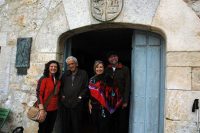
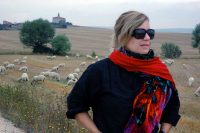
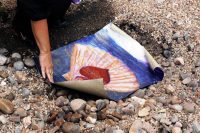
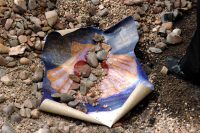
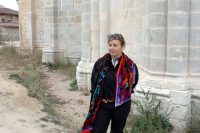
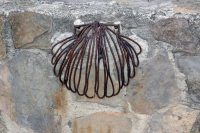
I wanted to enter again the Romanesque church of San Juan de Ortega, which is known for its Virgin, illuminated at each summer solstice. At this time of year a ray of sunshine passes through one of the rose windows of the church and lights up the Virgin’s womb. I chose to plant the painting with the shell and heart of Mary behind the church. On the way to Castrojeriz, we passed the ruined convent of San Anton, today a refuge for summer pilgrims, besides being a 14th century Gothic monument with Romanesque reminiscences. For several centuries, San Anton functioned as a kind of toll station on the Way: pilgrims had to leave some bread, wine or money there. All that remains today are the arches and the vault of the sky. There I left the painting of the shell with the crown. Following the longest street on the journey – about two kilometers long – one comes across the college of Santa Maria del Manzano, from where one can see the church of San Juan with its flanks dominated by the ruin of a castle that was the cause of dispute in the 9th and 10th centuries between Moors and Christians. I decided to leave the two other paintings inside the ruins of the fort: one of the shell with the cross of Saint James, the other with the golden arrow. Once my paintings were planted, I began to take my leave of these sun-drenched plains. I will only be back here in a few months’ time to plant other paintings that will move further ahead towards Santiago.













